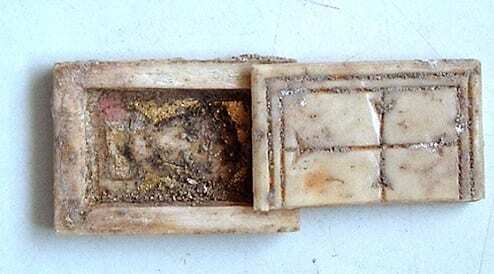Archaeologists from the Israel Antiques Authority have uncovered a decorated miniature box from the Byzantine period in the walls that surround the Jerusalem National Park.
The box, which dates to the Byzantine period (sixth-seventh centuries CE), is adorned on the inside with the drawings of two figures (icons) surrounded by a background lined with gold leaf, and it seems that the artifact was used as a personal prayer relic.
The box is 2.2 cm long by 1.6 cm wide and is made of a bone taken from a large animal (steer, camel or horse). The box slides open. When doing so it includes two flat parts, each of which bears a colored drawing. According to Yana Tchekhanovets, director of the excavation together with Dr. Doron Ben-Ami of the Israel Antiquities Authority, “The use of icons (cultic objects portraying sacred figures) for prayer outside the church is a phenomenon known in the Christian world already in the fifth century CE.
However, the painted holy relics that date to the Byzantine period which were discovered here, in the Holy Land, are extremely rare, thus making this an exceptionally important discovery. Folding icons for personal use are known to this day in modern Christendom, especially in the East. The box was discovered intact, apart from a small crack, and the fact that it was hermetically sealed ensured the preservation of the drawings on the relic’s inner panels”.
The image of a bearded man against a gold background is portrayed in the drawing at the bottom of the box. His face was only partially preserved, although it is possible to discern its general shape, the dark shade of his hair and his left eye. The details of his garment can be identified, which include a white cloak with a pink spot located on its right shoulder – almost certainly a white tunic and purple stripes.
The preservation of the drawing on the inside of the box’s lid was even more fragmentary. From the remaining details it is possible to reconstruct the shape of a smaller figure, probably a female, draped in a blue garment, against a gold background. The face of the figure was not preserved; however, we can discern the lines of hair (or a head scarf?), chin, neck and part of the left shoulder.
In the absence of a mechanism for suspending the relic, we can assume that the tiny object was preserved in a small cloth bag. In sealed caves that were excavated in Moshchevaya Balka, in the northern Caucus in Russia, small cloth bags such as this were preserved intact, among other things, which were found on the bodies of the deceased. Based on the context in which they were discovered it was determined that men carried them on a belt around their waist and women wore them on the upper part of their dress.
According to Tchekhanovets, “Because of the poor state of preservation of the drawings in the box any attempt at identifying the figures would almost certainly be within the realm of conjecture. There are several possibilities that can be suggested: if we assume that the drawings depicted are those of a man and women the obvious possibility then is Jesus and Mary. However, in the sixth and seventh centuries CE (the date of the box) the number of saints venerated by the Christian church increased to many hundreds, two of which are probably portrayed in the drawings here.
In recent years the excavations in the Giv’ati car park have uncovered remains of the Byzantine settlement there spread across a wide area. These remains mainly included an administrative type building, a large farming terrace and a paved street, 25 meters of which have been exposed to date. A series of plaster floors was discovered in the western part of the paved street. The box was discovered after the upper floor was dismantled.
Israel Antiques Authority
Header Image Credit : IAA





